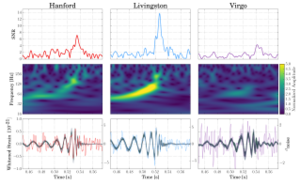User:Camomilla88/sandbox
The Injection system[edit]
The injection subsystem (INJ) is the interface between the pre-stabilized laser system (PSL) and the interferometer (ITF) input. Its function is to deliver a beam to the ITF input port with the required power, geometrical shape, frequency and angular stability.
The INJ design was made to be compliant with the AdV specifications, in particular to deliver up to 125 W to the ITF, with the required stability. For this reason, the components used have been chosen for high power operations.
The functions of the INJ subsystem are implemented by means of devices and optical components. A system of Electro Optics Modulators (EOMs) provide the radio frequency modulations needed for control and sensing of the ITF optical cavities. The Input Mode Cleaner (IMC) cavity geometrically cleans the beam and reduces its amplitude and lateral fluctuations. In transmission of the IMC a photodiode provides the error signal for the intensity stabilization of the laser. An in-vacuum Faraday isolator prevents spoiling the laser power stability and, finally, a mode matching parabolic telescope is used to properly match the beam on the interferometer.
More informations can be found on the Virgo TDR [1]
The Advanced Virgo detector[edit]

The Advanced Virgo aims to be 10 times more sensitive than the initial Virgo.[2] According to the Advanced Virgo Technical Design Report VIR–0128A–12 of 2012, advanced Virgo keeps the same vacuum infrastructure as Virgo, with four additional cryotraps located at both ends of both three-kilometre-long arms to trap residual particles coming from the mirror towers, but the remainder of the interferometer has been significantly upgraded. The new mirrors are larger (350 mm in diameter, with a weight of 40 kg), and their optical performances have been improved.[1] The critical optical elements used to control the interferometer are under vacuum on suspended benches. A system of adaptive optics was to be installed to correct the mirror aberrations in-situ.[1] In the final Advanced Virgo configuration, the laser power will be 200 W.
A milestone for the Advanced Virgo was reached in 2017 with the installation of the new detector. A first joint science run with LIGO, in the second half of 2017, started following a commissioning period of a few months.
The first detection of gravitational waves by Virgo is known as GW170814, which was announced on 27 September 2017 in a G7 science meeting conference in Turin, Italy.[3][4]
Just few days later, GW170817 was detected by the LIGO and Virgo on 17 August 2017. The GW was produced by the last minutes of two neutron stars spiralling closer to each other and finally merging, and is the first GW observation which has been confirmed by non-gravitational means.
The full design sensitivity of the Advanced Virgo should be achieved in 2019.
- ^ a b c Many authors of the Virgo Collaboration (13 April 2012). Advanced Virgo Technical Design Report VIR–0128A–12 (PDF).
- ^ Acernese, F.; Agathos, M.; Agatsuma, K.; Aisa, D.; Allemandou, N.; Allocca, A.; Amarni, J.; Astone, P.; Balestri, G.; Ballardin, G.; Barone, F.; Baronick, J-P; Barsuglia, M.; Basti, A.; Basti, F.; Bauer, Th S.; Bavigadda, V.; Bejger, M.; Beker, M. G.; Belczynski, C.; Bersanetti, D.; Bertolini, A.; Bitossi, M.; Bizouard, M. A.; Bloemen, S.; Blom, M.; Boer, M.; Bogaert, G.; Bondi, D.; Bondu, F. (2015). "Advanced Virgo: a second-generation interferometric gravitational wave detector - IOPscience". Classical and Quantum Gravity. 32 (2): 024001. arXiv:1408.3978. Bibcode:2015CQGra..32b4001A. doi:10.1088/0264-9381/32/2/024001.
{{cite journal}}: Unknown parameter|displayauthors=ignored (|display-authors=suggested) (help) - ^ "European detector spots its first gravitational wave". 27 September 2017. Retrieved 27 September 2017.
- ^ Cite error: The named reference
paperwas invoked but never defined (see the help page).

